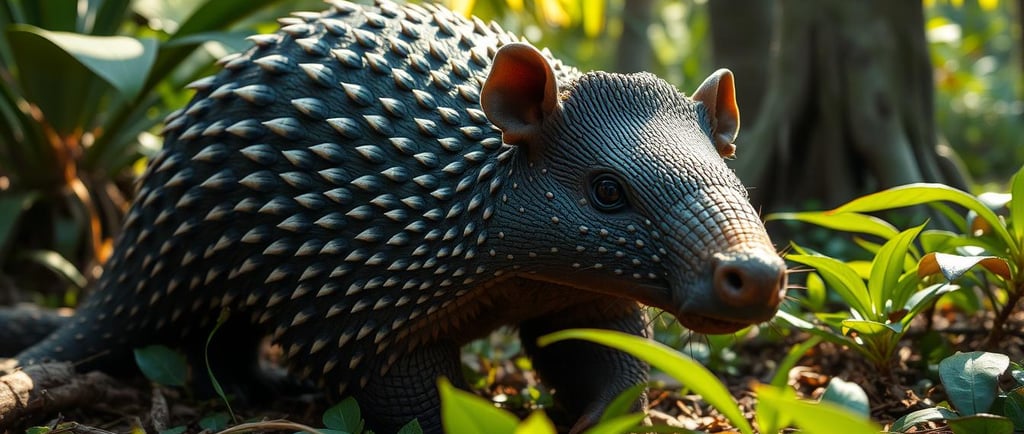Discover Florida Armadillo: Your Guide to Local Wildlife
Did you know Florida has over 160 butterfly species? About 200 different ones pass through each year. Yet, another fascinating creature often goes unseen - the nine-banded armadillo. These armored mammals roam Florida, from the Keys' coral reefs to the Panhandle's cypress swamps.
WILDLIFEFLORIDA'S NATURE COASTNOT THE ORDINARY


Discover Florida Armadillo: Your Guide to Local Wildlife
Did you know Florida has over 160 butterfly species? About 200 different ones pass through each year. Yet, another fascinating creature often goes unseen - the nine-banded armadillo. These armored mammals roam Florida, from the Keys' coral reefs to the Panhandle's cypress swamps.
Armadillos are most active at night, especially in summer's cool evenings and winter's warmest hours. They like temperate weather and burrow to stay cool or warm. Myakka River State Park in Sarasota is a great place to see them. There, visitors can watch them forage and even spot their quadruplet litters.
Key Takeaways
Florida is home to over 160 species of butterflies and approximately 200 passing through the state each year.
Nine-banded armadillos are nocturnal creatures found throughout Florida, from the Keys to the Panhandle.
Armadillos are most active during cool evenings in summer and warm parts of the day in winter, preferring temperate weather.
Myakka River State Park in Sarasota is a popular spot for florida wildlife sightings, including armadillos.
Armadillos are known for their identical quadruplet litters and unique burrowing behavior.
Introduction to Florida's Armored Wanderers
The nine-banded dasypus novemcinctus, a member of the xenarthra order, thrives in Florida. These burrowing mammals were brought to Florida in the early 1900s as pets. Now, they are common, adapting well to the climate and habitats.
Historical Background in the Sunshine State
Armadillos are not native to Florida but have spread from South America. The nine-banded armadillo was first seen in Florida in the 1920s. Their numbers have grown, making them a key part of Florida's wildlife.
Physical Characteristics and Adaptations
These armored mammals have a shell that protects them from predators. They have long claws for digging and a strong sense of smell for finding food. Despite bad eyesight, they can jump 2 feet high when scared.
Natural Distribution Patterns
The nine-banded armadillo lives in many places in Florida, like forests and suburbs. They are found in large numbers in places like the Ocala National Forest and Myakka River State Park.
Location Armadillo Population Ocala National Forest Extensive Myakka River State Park Impressive Paynes Prairie Preserve State Park Haven
As armadillos thrive in Florida, they play a big role in the ecosystem. They help control insects and shape the landscape.
Florida Armadillo: Habitat and Behavior
The nine-banded nocturnal insectivore known as the Florida burrowing mammal is a fascinating part of the state's florida wildlife. These unique creatures thrive in a variety of habitats across the Sunshine State.
Armadillos in Florida prefer woodlands, forests, and areas with soft, rich soil. This allows them to easily burrow underground. They are most active at dawn and dusk, showing their nocturnal nature. Digging extensive networks of burrows is a key characteristic of these burrowing mammals, as they seek shelter and hunt for insects and other small prey.
Interestingly, armadillos are skilled swimmers. They can inflate their stomachs and intestines with air to achieve buoyancy. They can even remain underwater for up to six minutes! When startled, armadillos have a unique defensive mechanism - they jump straight up, which unfortunately contributes to their frequent roadkill status.
These florida wildlife creatures also have a musky odor that intensifies when they feel threatened. They can make grunting and squealing noises to communicate. With their distinctive appearance and fascinating behaviors, the armadillo is a captivating part of Florida's natural landscape.
Characteristic Statistic Weight 9-12 lbs, with the capability of reaching up to 20 lbs Lifespan 8-12 years in the wild, and up to 20 years in captivity Home Range 15-20 acres in summer, 2-8 acres in winter Burrows Each armadillo maintains around 10 burrows, reaching depths of up to 7 ft and lengths of 20 ft Distribution Expanded at a rate of 7 km/year since arriving in the US Reproduction Only vertebrate known to exhibit obligate polyembryony, producing litters of four genetically identical young
"Armadillos are a captivating part of Florida's natural landscape, with their distinctive appearance and fascinating behaviors."
Fascinating Facts About Armadillo Biology
Armadillos, the enigmatic anteater relatives found in Florida, are fascinating creatures with unique biological traits. They have remarkable reproductive abilities, defensive mechanisms, and foraging habits. These traits offer a glimpse into the remarkable diversity of the natural world.
Unique Reproductive Traits
Armadillos have a remarkable ability called polyembryony. A single fertilized egg can develop into identical quadruplets. This makes them valuable for medical research, as the genetically identical offspring help study development and disease.
Defensive Mechanisms and Abilities
Most armadillo species, including the nine-banded armadillo found in Florida, cannot roll into a ball for protection. Instead, they use their armored shell and quick burrowing to escape predators. Surprisingly, these can armadillos run fast, reaching speeds of up to 30 miles per hour despite their bulky appearance.
Dietary Preferences and Foraging Habits
Armadillos are primarily leprosy carrier and insectivorous. Their diet mainly consists of insects, grubs, and small invertebrates. They use their long, sticky tongues to capture prey, locating it with their keen sense of smell. Their anteater relative status is evident in their digging and burrowing for food.
These unique biological characteristics make armadillos fascinating creatures to observe and study. As we explore Florida's natural wonders, understanding armadillo biology deepens our appreciation for the diverse wildlife in the state.
Best Locations for Armadillo Spotting
For those who love nature and wildlife, seeing a nature coast armadillo in Florida is thrilling. These special florida wildlife can be found in many great spots across the Sunshine State.
The Ocala National Forest is a top place to see armadillos. They like to be near springs and sandy banks. There, they hunt for ants, termites, and other small bugs.
Myakka River State Park is also great for spotting armadillos. The best times are early morning and late afternoon. This is when they are most active.
Paynes Prairie Preserve State Park is another place to see florida wildlife. Here, you can find nature coast armadillo along the La Chua Trail.
Armadillos can also be seen in rural areas, forest edges, and even suburban backyards. The best times to see them are just before sunset or early in the morning. This is when they come out to look for food.
Location Best Time for Sightings Key Highlights Ocala National Forest Anytime Near springs and sandy banks Myakka River State Park Early morning, late afternoon Excellent for observing armadillos Paynes Prairie Preserve State Park Anytime Along the La Chua Trail Rural areas, forest edges, and suburban backyards Just before sunset, early morning Armadillos are commonly seen
With patience and a sharp eye, visitors can see nature coast armadillo in Florida. These florida wildlife creatures are fascinating to watch in their natural homes.
Living with Armadillos: Challenges and Solutions
Armadillos are becoming more common in Florida. Homeowners face the challenge of managing them on their properties. These creatures, with their armor-like shells, can harm lawns, gardens, and foundations.
Common Property Concerns
Armadillos love to dig, which can ruin lawns and flower beds. Their holes are shallow but can make the landscape look bad. They also dig up areas with soft soil while searching for insects and grubs.
Humane Prevention Methods
Install fencing that extends at least a foot into the ground to deter armadillos from accessing your property.
Consider using Dig Defence® Animal Control products, which can effectively exclude armadillos from specific areas.
Avoid using black or rubber mulch in flower beds, as these materials can create favorable conditions for grubs, which attract armadillos.
Wildlife Management Tips
Armadillos are usually not aggressive, but it's wise to keep a safe distance. If you need to remove them, contact wildlife experts. Keeping your garden in good shape and reducing insect numbers can also help keep armadillos away. By understanding their habits, you can live peacefully with them.
"Armadillos are generally non-aggressive, but it's best to observe them from a safe distance and contact wildlife professionals for removal if necessary."
With some planning and action, you can manage living with armadillos. Enjoy the unique wildlife that Florida has to offer.
Conclusion
Florida's florida armadillo are fascinating creatures that play a unique role in the state's florida wildlife. They can sometimes be seen as a nuisance because of their digging. But, they also help control insects and add to biodiversity.
Knowing how they behave and where they live helps us manage our interactions with them. With the right knowledge and humane ways, Floridians can live alongside these armored wanderers. We can appreciate their role in Florida's wildlife.
The study by Sharma et al. shows a link between armadillos and leprosy in Florida. This is important for people with progressive neuropathy, even if they haven't traveled. The rise in leprosy cases matches the increase in infected armadillos, showing we need more research and awareness.
As we learn more about Florida's armadillos, it's clear they are crucial to the ecosystem. By accepting them and using responsible management, Floridians can live in harmony. This way, the natural beauty and biodiversity of Florida will be preserved for future generations.

